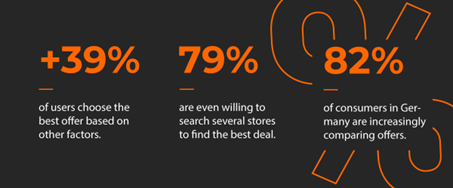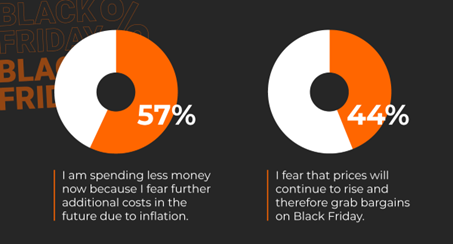This is not another assessment on the status of the e-commerce in 2022. Instead, let’s look at how you can use a price comparison to easily attract new customers and thus also respond to the current challenges in the e-commerce market.
More precisely: Let’s take a look at how customer acquisition via a price comparison can play an important role in the future development of your company.
How so? Today’s customers will very likely be tomorrow’s customers. Accordingly, it is worth investing in the acquisition of new customers now, as they will remain loyal to you even in a more relaxed market environment and will also scale in terms of expenditure in parallel with rising sales.
In a nutshell: Existing customers buy more and more frequently, they make recommendations, and they have a higher customer lifetime value*. Thus, they are a truly very valuable resource for the success of a company.
Consequently, we have a few straightforward arguments in favor of converting website visitors into customers.
In addition, a thought from business psychology: long-practiced behaviors on the customer side are changed especially in times of great uncertainty and crisis. **
SUMMARY
1. From visitor to customer: two approaches in times of uncertainty
The exciting question is: What is the smartest way to attract new customers in times of high-cost sensitivity?
There are several behavioral changes that we have observed among idealo.de users that can be used for this purpose. We would like to highlight a few of them here. After all, these changes are good signposts for how you can win these users as customers. It is also our assumption that the idealo user is not too different from the average internet user and that the insights are therefore transferable to other channels.
On the one hand, we have the changes that fall into the “reaction to inflation” category.

Looking directly at Black Friday, Do you plan to spend more/less? What are the reasons?
57% agreed with this ratio: I am spending less money now because I fear further additional costs in the future due to inflation. On the other hand, 44% identified with this statement: I fear that prices will continue to rise and therefore grab bargains on Black Friday.

So, we’re talking about a couple of “cold” factors here that run purely on ratio.
However, there is a second level to this, which is not primarily about the quality of the offer, but about how trustworthy a retailer appears.
To this end, our UX team launched a survey that essentially asked this question: “How do you determine for yourself whether a store you don’t know is trustworthy?”
The following criteria emerged as important – i.e. indicated as a factor by more than 50% of the respondents:
- reviews from other users
- buyer protection and payment methods
- Trustworthy information about the business running the webshop
Seals and certificates, on the other hand, turned out to be less relevant.
The results could be interpreted as follows: In the end, it comes down to hard evidence, such as known and familiar payment methods as one of the strongest factors. Factors, in other words, that are difficult to change and are – at least perceived to be – beyond the merchants’ control.
The best thing about these factors is that they are long-lasting. While a campaign, no matter how creative, quickly loses visibility or wears out, these elements retain their pull factor without much wear and tear.
We want to throw another factor into the ring: If companies cannot respond to customers’ feelings, this has an impact on the purchase decision*.
What we have seen before (stronger price comparison, more frugality) implies an emotional world that can be described reasonably well with “uncertainty” and “fear”. The appropriate response to this: confidence.
In other words, precisely what factors 1-3 convey.
In short: There are very good reasons to continue to focus on customer acquisition.
2. It’s time to publish on price comparison websites.
Factors that are easy to influence and inexpensive have a big impact on whether a webshop visitor becomes a new customer. Once they become one, they will – very likely – stay loyal to the webshop and they will need to spend less the next few years to bring in more profits.
Now is a potentially good time for acquiring new customers, because customers change their attitudes more easily during crises and currently rely heavily on rational arguments.
The great advantage of comparison platforms: All the factors mentioned are very salient here and easy to see – across different providers. So, if you meet all of them, that’s an immense advantage over your competitors, and with potential customers who probably didn’t even know you until then.
That said, it remains to be noted: A bad purchasing experience can quickly destroy the trust you have gained. Accordingly, the most important thing is to establish a good infrastructure with seamless data flow, and idealo works closely with technology partners like BeezUP to achieve this.

Jan-Niklas Runge
Jan-Niklas Runge has been working at idealo since 2022 and has previously gained experience in the B2B sector as well as in innovation and business psychology
About idealo
idealo internet GmbH is one of Europe’s leading price comparisons with over one million visitors per month in the UK Market, and more than 70 million site visits per month in all idealo countries, making us the price expert in online commerce. On idealo in Germany, Austria, France, Italy, Spain and UK, consumers can compare up to 400 million offers from over 50,000 merchants. As one of the biggest brands in e-commerce in Europe, we stand for transparency and fair competition in online shopping.




